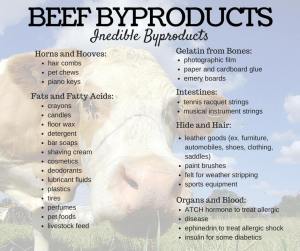What exactly is a byproduct? A byproduct is an incidental or secondary product made in the manufacturing or synthesis of something else.
So what does that mean for the beef industry? It means that once we have the meat (which is the main reason we raise cattle) the “leftover parts” can be made into other products.
If you have a beef animal that weighs 1,000 pounds, 640 pounds of the animal will be used for meat products, such as steaks, roasts and hamburgers. This means 64% of the animal is used for meat. However, 99% of the cow is utilized for meat and other products. This makes the beef industry more sustainable because it uses as much of each cow as possible.
There are three categories of animal by-products: edible, inedible, and medicinal.
EDIBLE

Photo via Alabama Cattlemen’s Association
INEDIBLE

Photo via Alabama Cattlemen’s Association
or 20 footballs or 18 volleyballs or 18 soccer balls or 12 baseball gloves. Industrial oils and lubricants, soaps, lipsticks, deodorant, and many other items are produced from the inedible fats from beef.
MEDICINAL
More than 100 individual drugs include beef byproducts. The medicines can help make childbirth safer, can settle an upset stomach, can prevent blood clots, control anemia, and help relieve asthma symptoms. Antirejection drugs, which are used when a person has a transplant to help the body accept the new organ, come from animal byproducts. Insulin, which is used 1.25 million people daily in the United States, can come from livestock or be synthetically produced. It takes the pancreases from 26 cattle to provide enough insulin to keep one diabetic person alive for a year.
So “Where’s the Beef?”
So when people ask you where’s the beef, you will know the truth, it is in more places than just your fridge or on your plate. It is in hospitals, drug stores, helping your car run better, sporting goods, art supply shops, soap, and many other things.
[…] same is true today. On average, 64% of a heifer or steer is used for meat, but 99% of the animal is used. Cattle by-products provide […]